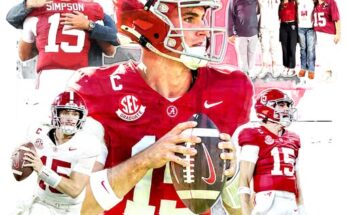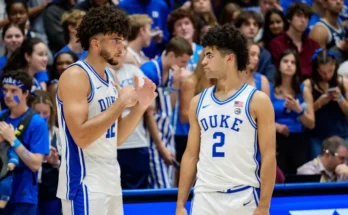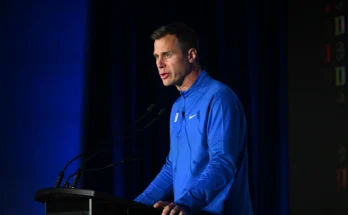Notre Dame Revamps Blue-Gold Tradition to Meet the Demands of Modern College Football
For decades, the Blue-Gold Game has been more than just a spring football scrimmage at Notre Dame — it’s a tradition steeped in history, a glimpse of what the next season holds, and an opportunity for fans to witness the future of the Fighting Irish on the hallowed ground of Notre Dame Stadium. But in an era where college football continues to evolve at a rapid pace, the Blue-Gold Game has had to adapt, just like the sport itself. With shifts in recruiting, NIL (Name, Image, Likeness) opportunities, the transfer portal, and a heightened emphasis on player safety and performance metrics, the event is no longer just a nostalgia-filled scrimmage between two teams in blue and gold jerseys. It has become a key component of how Notre Dame prepares for the challenges ahead, while also staying true to its storied legacy.
For fans, it’s the ultimate early preview — the first taste of how the roster is shaping up and the first chance to see the freshmen, transfers, and returning players in action. For coaches and players, it’s a crucial opportunity to assess talent, implement new systems, and fine-tune strategies ahead of the fall season. The days of simply putting on a show for the faithful in the spring are behind them. The Blue-Gold Game now serves a more strategic purpose as the Irish continue to pursue national championships and build a program that can compete at the highest levels in a landscape where competition is fierce and the game is constantly shifting.
So how has Notre Dame adapted its Blue-Gold Game to match the evolving college football scene? Let’s take a look.
Shifting Focus: From Exhibition to Evaluation
Under head coach Marcus Freeman, the Blue-Gold Game has shifted away from its traditional role as a laid-back, fan-friendly event to a more focused evaluation of the team’s current state. While the game still provides the fanfare and excitement associated with the tradition, it now carries with it an increased level of intensity.
For Freeman and his staff, the focus has changed from just putting on a spectacle to assessing key areas of need, evaluating position battles, and analyzing how well the team adapts to new schemes and strategies. The influx of new players, whether through recruiting or the transfer portal, has made the Blue-Gold Game a crucial opportunity to see how different players fit into the system.
This shift is indicative of the larger trends within college football. With the added pressure of NIL deals and the constant churn of the transfer portal, the Blue-Gold Game serves as a critical piece of the puzzle for Freeman and his coaching staff. As the game continues to evolve, Freeman’s philosophy is clear: The event is no longer just a chance for fans to get a sneak peek of next season; it’s a full-on evaluation that helps the coaching staff get a sense of how they can compete for a national title.
The role of the quarterback, in particular, has come under increased scrutiny in recent years, and this year’s Blue-Gold Game is no exception. With a group of talented quarterbacks competing for the starting role, all eyes will be on how well they command the offense, execute the plays, and demonstrate leadership. The stakes are high, and there is no room for simply “going through the motions.” Freeman’s high-energy, detail-oriented approach demands more than just participation; it requires players to step up and prove their worth.
Embracing the Transfer Portal and Fresh Faces
One of the most noticeable changes to the Blue-Gold tradition in recent years is the growing influence of the transfer portal. Notre Dame’s recruitment strategy has evolved to reflect the rapidly changing college football landscape, with transfers now playing an integral role in building the program’s future.
The Blue-Gold Game has become the ultimate showcase for these new faces, especially for players who joined the team after the traditional signing period. For many, this spring game is their first official chance to prove themselves to the Notre Dame faithful. And while these transfers often bring much-needed experience and immediate impact to the roster, the game also presents an opportunity to see how well they gel with the existing team.
This year, Notre Dame’s 2025 squad includes several key transfers who are expected to make an impact, and the Blue-Gold Game is the perfect platform for them to showcase their talents. Fans will be eager to see how new running backs, wide receivers, and defensive players settle into the system, adding another layer of intrigue and excitement to the spring contest.
These players are coming from programs where they have already displayed their ability, but Notre Dame’s unique culture and academic requirements set the stage for a different level of competition. The transfer portal has allowed Freeman to address immediate needs while maintaining the program’s values, creating a blend of youth, experience, and talent that sets up the Irish for success in the seasons to come.
Fan Engagement in a New Era
In the past, the Blue-Gold Game was the highlight of the spring football calendar for Notre Dame fans. It was a day to celebrate the program’s history, reconnect with alumni, and catch a glimpse of the team before they took the field for the upcoming season. The tradition was simple, yet powerful, and the event always had a sense of warmth and community.
However, in the age of social media and instant gratification, fan engagement during the Blue-Gold Game has been transformed. While the game still draws fans to Notre Dame Stadium, it’s no longer just about those who can make it to the game in person. The entire event is now live-streamed, with coverage extending well beyond the confines of the stadium to social media platforms and digital channels. This expanded coverage allows fans from all over the world to take part in the action, even if they can’t physically attend the game.
For the program, this increased exposure has been a boon. Coaches and players now have the opportunity to connect with fans in ways that were previously unimaginable. Fans can get behind-the-scenes access, interviews with players, and exclusive content leading up to and following the game. This broader reach makes the Blue-Gold Game an event that extends far beyond the 48 minutes of action on the field. It’s a true celebration of Notre Dame football, one that highlights the culture, history, and future of the program.
This digital expansion of the Blue-Gold tradition is essential in keeping the program relevant in the ever-changing landscape of college football. In an era where recruits are highly attuned to social media and digital engagement, the increased access to the team allows Notre Dame to stay connected with its global fanbase, helping to maintain its position as one of the most prestigious programs in the country.
Moving Forward: A New Chapter in a Rich Tradition
The changes to Notre Dame’s Blue-Gold Game represent more than just cosmetic shifts. They are a reflection of the program’s adaptation to a rapidly evolving landscape. The days of relying solely on tradition to carry a program are behind us. In the modern world of college football, where money, media, and technology shape every aspect of the game, teams must constantly evolve to remain competitive.
But despite these changes, the core values of Notre Dame football remain firmly intact. The Blue-Gold Game may look different than it did in decades past, but the spirit of the event — the passion, the pride, the legacy — remains the same. It’s still an opportunity to showcase the next generation of Fighting Irish stars, and it’s still a symbol of the program’s relentless pursuit of excellence.
For fans, it’s a chance to be a part of something larger than a single game or season. It’s a chance to witness the evolution of a tradition that will continue to thrive well into the future. And for the team, it’s a vital checkpoint on the road to greatness.
As Notre Dame adapts to the demands of the modern game, one thing is certain: the Blue-Gold Game will continue to be a symbol of the program’s commitment to excellence, its embrace of change, and its vision for a brighter future.



